The Preservation of Momentum Theme
The preservation of momentum skill theme is all about putting Mario in situations where it would be best to get out quickly, and then slowly making that escape more and more difficult. The stats on this theme are exactly what one would expect. This theme features the biggest average d-distance and the largest delta height, both of which make sense given the qualitative aspects of the theme. Because Mario needs to keep up his momentum to get through challenges quickly, that same momentum is going to make it easier for him to gain critical height and distance on his jumps. Moreover, this means that if the player doesn�t keep up Mario�s momentum, it will greatly endanger him. This negative feedback loop is a key part of this theme. Obviously, Mario can regain momentum, and this game is rarely very difficult, but the onus on speed in this theme is very different from the focus of other themes. Both the periodic enemies and moving targets themes have as their core skill the timing jump, in which waiting in a relatively safe place is common. As for intercepts, even when those intercepts damage Mario, many are only a threat for an instant. Now, these �spikes� in difficulty are relative to a fairly easy game. But as we�ll see throughout the theme, even when Mario isn�t faced with a 2-penalty pitfall or the like, challenges can get (relatively) more difficult all of a sudden. It�s not the difficulty that�s important, but rather the sudden change in it stemming from lost momentum.
Like its fellow on the platforming side of the composite, the preservation of momentum theme is heavy on iteration and somewhat light on accumulation. Only the pinnacle level, Awesome, demonstrates level-wide accumulation. But the iterations in this theme are a lot more appreciable for the player than they are in the moving targets theme, because of how different they all look and feel�even if the underlying mechanics of each level aren�t that different. That difference in feel stems from the feedback that drives the player: there�s always some glaring reason to keep moving. The theme begins this with sinking platforms in Yoshi�s Island 4.

Although they�re hardly any danger, the sinking action of these platforms will keep the player moving forward by simple, safe necessity. Skipping ahead a bit a similar thing occurs in Star World 5, which features a long gauntlet of falling platforms too. These two levels are not close to each other chronologically, but it�s interesting that they are two out of only three levels in the game to make use of the traditional sinking/falling platform in a fully developed cadence. Falling or sinking platforms were, up to this point in Mario history, a staple of the game; they appear infrequently and only in greatly altered forms here.
This change makes sense when looking at the rest of the levels, because the designers had no problem implementing other reasons for Mario to keep going. In Donut Plains 4, the player faces rising pipes and lots of overhead intercept enemies.

This level is actually the first to introduce overhead intercepts, and it does so outside the intercepts theme. (This is the only time this happens.) But both the extending pipes and Hammer Brothers give Mario excellent reasons to keep going. The former requires momentum to gain the proper height and beat the full extension of the pipe, and the latter involves a relatively dangerous enemy whose death is unnecessary, grants no reward, and is just as easily bypassed as fought. Add to that the endlessly falling enemies in the second half of the level, and it becomes very clear to the player that it�s best to run rather than fight.
Mounting danger is the single most-used design idea for pushing Mario through challenges at high speed. In particular, enemies that spawn periodic projectiles in a confined setting make for challenges that are best attempted without stopping. That is to say, timing isn�t the core skill, or else these would be periodic enemy challenges. At first, this is very clear. Forest of Illusion 4 brings back the extending pipe, but this time also throws in the hovering Lakitu who will rain down Spikey enemies constantly. Lakitus dwelling in the pipes do this too.

The Spikey enemy isn�t invincible, but it is harder to kill than a normal enemy, and so it�s better for Mario to just flee. The high and/or extending pipes and Lakitus just make jumping with momentum a greater necessity. Some of this carries over into Chocolate Secret and Valley of Bowser 4, which both feature projectile-launching Chucks.

The reason this isn�t a periodic enemy challenge is there�s no timing jump or short, well-timed run which solve the essential problem. In each case Mario is vulnerable to the projectile until he gets through the whole challenge, and each challenge is fairly wide. So while timing certainly helps the player to begin a challenge, it�s the skill of keeping up Mario�s momentum with reflexes and �reading ahead� in the terrain that carry the player to victory.
Now the most prevalent trend in this theme is that Mario�s momentum must be maintained even while it becomes harder and harder to do so because of obstacles of increasing complexity. The pinnacle for the theme turns this on its head by making it almost impossible to stop Mario�s momentum. The level in question is Awesome, which uses icy platforms that preserve Mario�s momentum even when the player doesn�t want it. This icy terrain first appears in Donut Secret 2, which is vastly simpler than Awesome even if the basic ideas are the same throughout.

Many of the challenges in this level look like they would be rather easy except for the icy terrain which makes control of Mario�s momentum more difficult. This highlights the core skill of the theme; it isn�t about merely rushing headlong into every situation, it�s about controlling Mario�s momentum. It�s easy to get Mario running, but controlling that momentum precisely is what this theme is all about, because messing up a key jump with full momentum will bring on the negative feedback loop as much as a lack of momentum will. Awesome really hammers this home in the second half of the level. This section is the theme�s big accumulation, combining mounting waves of enemies with the icy platforms.

The combination is tough�not only does the player have to deal with a really large number of enemies that form walls of damage around Mario when he stops, but the player has to do it with less control of Mario�s momentum. In other words, the player really needs to be able to think ahead because small miscalculations will become big problems in this level very quickly. Really, this is one of the more frustrating accumulations in a theme, but it does definitely rely on skills taught by the rest of the levels.
YOSHI'S ISLAND 4
Like most of the skill themes, the preservation of momentum theme begins with the training-wheels challenge. Unlike the other themes that do this, though, the preservation of momentum theme has a problem: it has to convince the player to keep Mario moving. In order to force the player�s hand, an element of danger has to be introduced; avoiding that danger keeps Mario moving. Still, a training-wheels challenge only lives up to its name if removes the penalty, simplifies the action and softens the danger. This challenge does a good job of accomplishing everything in one go.

These platforms slowly sink into the water as Mario stands on them. The player will, eventually, react to this by jumping off the platform and onto dry land. The incentive to jump off the platform quickly and keep Mario�s momentum moving forward is obvious. Yet, the danger of the challenge is mostly negated because of the water below the platform. Even if the player waits and sinks, Mario won�t lose a life immediately. Thus, these challenges work perfectly to show the player the value of preserving Mario�s forward momentum and preserve an inexperienced player�s small stockpile of lives with an unconventional set of training-wheels.
The second challenge is the standard challenge for the level: two sinking platforms in sequence. While swimming in the water is possible, it�s slow and boring. Jumping on both of these platforms is fun�but the player needs to be quick about it, even if failing isn�t fatal. It�s a lesson handily learned by even inexperienced players, and so the evolutions start immediately after this challenge.

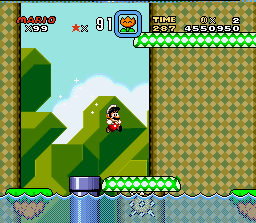
Here you can see the first proper intercepts of the level, but it�s important to recognize that one of those intercepts is actually not a danger at all. The left spike ball floats harmlessly under the dry-land platform, serving as a good warning shot that alerts the player of the spike ball which will intercept Mario on the upcoming challenge. For the preservation of momentum and intercepts themes, fast reactions and speedy �reads� of the terrain are essential skills. New players aren�t going to be very far along in developing those skills�indeed they may not even be aware of the possibility of this kind of intercept�and so this warning shot alerts them to it.
After this there is a bridge challenge, although it�s a very rudimentary one. Technically the bridge created by the p-block is a crossover, because it takes the emphasis off platforming and places it on action as Mario�s goal is to shoot a shell through several enemies. I call it rudimentary because this crossover involves action but doesn�t really belong to any skill theme; there are no intercepts, or significant periodic movements by enemies, or moving platforms. Obviously, this is forgivable because it�s such an early level, but pointing out what this challenge lacks is at least useful in helping to negatively define skill themes and bridge challenges, generally. There is one thing to give the designers credit for: this challenge breaks up the rest of the platform jumps rather nicely without sacrificing the underlying training-wheels (water) or asking the player to do too much.
After the bridge, the level�s main sequence begins with a basic expansion. Whereas there were two sinking platforms and one spiky ball, this is expanded to two intercepts, although the second intercept is actually travelling slower than all the rest in the level.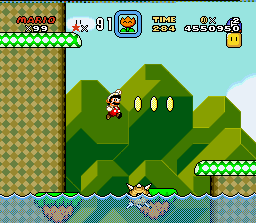
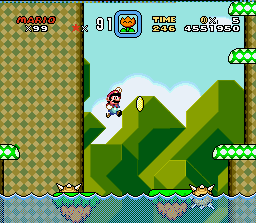
Again, this stems from a desire to make it easier on the players who are seeing their first expansion in the theme. Next there are three platforms and three intercepts, yet another expansion. The intercepts have all increased, as have the number of sinking platforms, but what hasn�t increased is the d-distances between these platforms. Three identical jumps of this kind are not mechanically more difficult than two identical jumps, but to a new player it can be psychologically more taxing. This is yet another example of positive deception on the behalf of the designers�something which we will see a lot in this theme.
Finally, there is a mutation challenge that illustrates one of the aspects of mutations which bears considerable study. This leaping fish stands in for the spiky intercepts of the previous challenges; naturally, it is different in appearance and behavior than the obstacle it replaces, but the kind of difference is important.
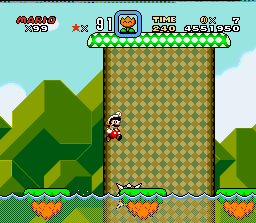
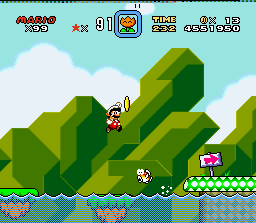
The jump this fish forces Mario to take is only slightly different. It�s a little higher and a little narrower as well. Momentum-wise, there�s no change. In essence, this jump is calibrated so that it�s no more difficult than the standard challenge, and indeed the skill the player is using is the same skill. What the mutation jump does best is to force the player to explore more of the nuances of a skill they�re already using comfortably, without necessarily demanding more of their skills to create that feeling of dominance without sacrificing knowledge gain. The way this jump controls for angle while maintaining virtually every other variable is a great example of how mutations are done, when they�re done well.
DONUT SECRET 2
The designers of Super Mario World, either by accident or because they knew and accepted the major flaw of the cape powerup, put in place numerous levels which force the player to use aspects of the cape that don�t involve sustained flight. Donut Secret 2 is one of the cleverer levels of this type. As I noted in section II, Super Mario World gets rid of the turn-and-slide mechanic present in SMB and SMB3. When Mario reverses course in Super Mario World, no matter how strong his momentum is, he will go in the new direction instantly so long as he is on the ground. This level does away with the new stop-on-a-dime mechanics and goes toward the other extreme. Everything is covered in ice, creating a low-friction surface that makes it much harder to reverse course quickly. Mario veterans will resort to the momentum-breaking jump that was so essential in earlier titles; new players will be learning that and a few other skills both essential and specific to the cape powerup. Essentially, what this level is out to do is force the player to use momentum-controlling (rather than momentum-halting) skills by taking away Mario�s ability to stop.
Often, levels that undermine one of a game�s fundamental mechanics (like being able to stop) can be terribly mean-spirited and generally disliked. It doesn�t make sense to teach your players to expect something and then take it away for spite. Donut Secret 2 gets away with it because of how well-placed all the level�s obstacles are. Players can�t halt Mario�s momentum, but they don�t need to.
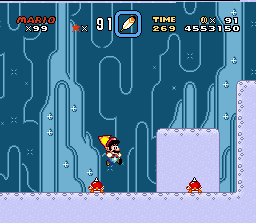
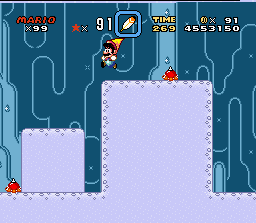
The spaces where Mario is supposed to land and then jump again are obvious. The key is that not only does Mario have to jump in the right places, but he needs to work with the icy momentum to get to the top of the high cliff and avoid the enemies. Combat is possible with the cape, but that will send Mario into a wall, breaking his momentum and causing him to have to start back along the slippery terrain away from his destination.
One thing that will help in almost all the jumps is a cape glide, which can give an airborne Mario the few moments the player needs to plan out the next few actions. Cape glides also help to preserve momentum where it�s especially useful, as in the case below.
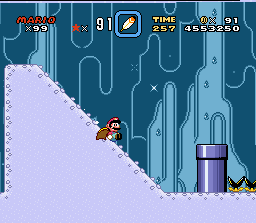
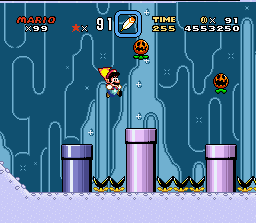
With the nearly inevitable momentum from the downhill, these two Leaping Pumpkin Plants lie in Mario�s most convenient jump-paths. At less than maximum height, however, a cape glide will cut across the pipes nicely. All the player has to do is break out of the slide without going to full height�or by peaking before the first Pumpkin and dropping beneath them with a glide. This is the first time in this skill theme that we have a precursor to the limited-height jump, although it is also applicable elsewhere in the level.
There are only two other real challenges in the main part of this level, and they�re both evolutions on the original idea. You can see on the left here how the empty platforms are now occupied with enemies.
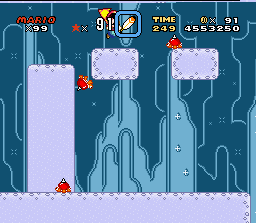
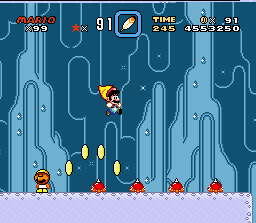
That�s a fairly standard evolution, adding a patrolling enemy that forces an earlier, more controlled jump. There�s also a small expansion-by-contraction, as those platforms are smaller than in the first example, but it�s only slight and still very standard. The challenge above and right, on the other hand, does something more interesting. Here we see a long line of enemies that necessitate good momentum for a long jump. The tricky part is getting over the whole group and still being able to catch the edge of the cliff and ascend. (A moving cape attack and/or the Koopa�s shell will also kill them all, of course, but hardly requires any analysis.) This is another good time for a cape glide, and it teaches a very important, but subtle, lesson: cape glides do not always need to continue all the way to the ground. Aborting a cape-glide mid-flight is an important skill, and this is probably the first instance where that skill is emphasized, so that Mario doesn�t glide right off the cliff edge.
As for the last two considerations in the level, we�ll take a look at the pipe section of the level, and the last semi-challenge. Both of these sections are nice touches that don�t necessarily fit the rest of the level, but are nevertheless worthy design lessons. The pipe section of this level, accessible from around the mid-point, sticks with the skill theme, but in a different way. These platforms will drop from under Mario after a second or two, necessitating a quick jump and continued momentum, and are nicely interrupted by a couple of Leaping Pumpkin Plants. Alternatively, Mario can use the P-balloon powerup.
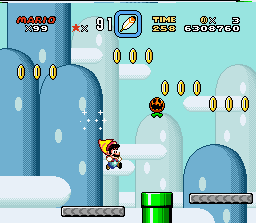
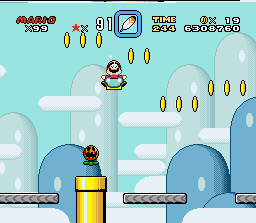
I will go on record expressing my distaste for the balloon powerup, and use this opportunity to explain some of that distaste. What does the balloon add here that jumping on the platforms doesn�t do more elegantly? Obviously there are coins here that suggest the same kind of easy learning for the balloon that Donut Plains 1 had for the cape in a similar situation. But the cape powerup is fast, nuanced and intuitive; this balloon section is slow, tedious and unhelpful. If the balloon were taken out, this section would still make sense with the rest of the level, and indeed would be a nice contrast, showing how the icy floors and falling platforms are two aspects of the same thematic idea, connecting them in the player�s mind.
The final challenge is a hallmark of Miyamoto games: the reward-with-fun. Here we see a stack of Koopas which are easily dispatched with one chain jump that grants a 1-up.
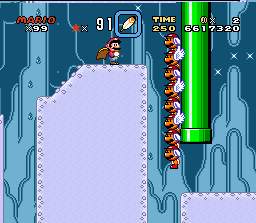
The designers do this several times in the game: giving the player an easy-but-flashy challenge that lets them feel dominant as a reward for completing harder sections. Not all feedback mechanisms need to be items or secrets or cutscenes; easy, flashy fun challenges will do just as well.
DONUT PLAINS 4
Donut Plains 4 is a clear example of how challenge evolutions need not be overly complex to be effective within a skill theme. For this level, the designers went with a slightly more abstract standard challenge from which they produce variations. The standard challenge is this:
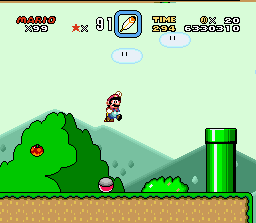
This challenge involves leaping to a higher platform to avoid an enemy that is better avoided than engaged, the rainbow-shelled Koopa. Now, it is possible to defeat this enemy before it becomes dangerous by running at a full clip. Without great speed though, the enemy activates and its irregular movements and resistance to ordinary damage mean it�s simpler to leap over it with a momentum jump or cape glide (or both). The point of the jump is to train the player to make the jump quickly and in full stride, because once the Koopa is inside the shell, the enemy is fast, fairly dangerous and unrelenting.
This next challenge I consider a mutation upon the standard challenge, but I admit that even I find the classification to be dubious. In fact, I think that this level, like a few others in the preservation of momentum theme, is where the classification system we have used does not work as well. The system is not perfect, and I do not claim it to be such. Ordinarily, a mutation isolates one aspect of a challenge and changes it so that the challenge is qualitatively different but no more or less complex, and not quantitatively different to a significant degree. This is not strictly true here.
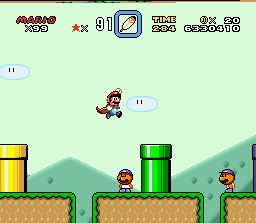
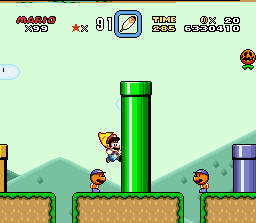
In the standard challenge, the player is jumping over a patrolling enemy and on to a slightly elevated pipe. That part is consistent. The details are not consistent, however. Instead of a rainbow shell, the player is jumping over a standard Koopa, although that Koopa is on a short patrol that closely resembles the rainbow shell�s own pattern. The big difference is that the landing zone of the jump extends upward, blocking Mario�s path. In the end, the delta height changes by four if the pipe extends, bringing it up to the height of the standard challenge. And the penalty in this situation goes up because there is a small bottomless pit, although I think that exists mostly to shorten the Koopa�s patrol, and not to kill Mario�but this is conjecture and the part where this classification falters. The part where this classification succeeds the best is in the results: mutation challenges are about psychological effects rather than neuro-muscular (thumb-skill) effects, as I have noted time and time again. The point of this mutation is to force players to keep moving faster, so that the extending pipes do not rise up and stop Mario�s progress. There aren�t any more extending pipes after the second one (which is an expansion/evolution of this mutation), but the psychological effect lingers: the player knows to keep up Mario�s momentum through challenges, even when it�s not immediately obvious that something necessitates it.
The next challenges fit more easily into the categories we�ve been using so far. This enemy, appearing for the first time, acts as an evolution upon the standard challenge. Whereas the standard challenge is a ground-based jump that demands momentum and a high arc, this enemy inverts everything. The momentum is still key; it�s much easier to defeat a Flyin� Hammer Bro by attacking him immediately, before he ascends and fills the screen with hammers, but he�s exactly the opposite of a Koopa. Koopas, like most enemies in the game (and indeed the whole series) are best defeated from above, by jumping on them. Not so, here.

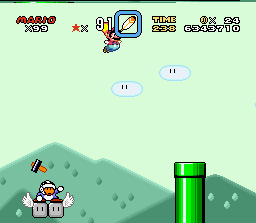
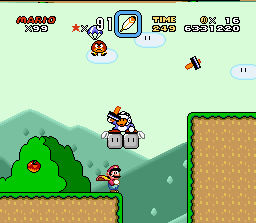
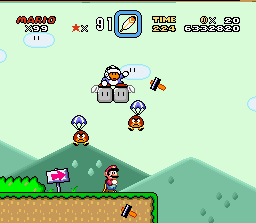
It�s possible to jump on a Hammer Bro, but it�s hard not to take damage while doing so because of the arc of his hammers. The only reliable way of defeating these Hammer Bros is to hit the platform below them, knocking them out. (Interestingly, the Hammer Bros in this level are actually irregular for the game�they throw half as many hammers as the ones in Forest 1, etc. Even here, the designers are breaking the player in slowly.) And it�s easy to see the way the challenges evolve here. The first two Hammer encounters are basically the same, the third adds intercepts, and the fourth adds more intercepts and a cliff�standard evolution fare. But in every case except the end it�s obvious that the player shouldn�t actually be engaging the Hammer Bro; the better option is escape. The corner-ramp in the first challenge, the cannon-pipe in the second challenge, the wide space in the third challenge all give the player a clear path to simply charge through and avoid the enemy entirely. It�s not as though there�s any great reward for defeating him.
In the next section, the designers have set up a great lesson on maintaining momentum through an enemy-bounce. Within the moving targets skill theme, the player will use enemy-bounce jumps to cross large divides; the enemy in question acts as a substitute for a platform. In those situations, it�s generally one enemy flying in empty space, alone above a bottomless pit. That�s changed here, and instead the designers give the player several pits full of Wing Goombas.
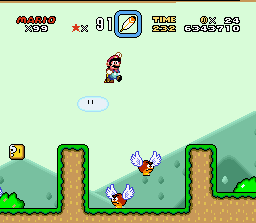
These pits, filled with enemies, are a relatively uncommon configuration in the game. What the designers are trying to do here is show the player how to use enemy-bounce jumps to preserve Mario's momentum. To that end they take away some of the danger by putting in a floor below the enemies, but to keep it from being a training-wheels challenge they have used Wing Goombas, which jump in a different pattern than the Wing Koopas the player is accustomed to. They also jump to a lower height, which, when combined with their elevation and the narrowness of the landing spots, means it�s much easier to do a shallow enemy-bounce (with or without accompanying shallow cape-glide). This shows the player how many of the skills from the moving targets theme, which has seen more development at this point, can be used in different ways for the preservation of momentum theme.
The last significant element in the level is an easy bridge challenge where enemies parachute down from the sky; it's a kind of intercept the player hasn't really seen yet, but will see plenty of times after this. The bridge challenge actually overlaps the final Hammer Bro, whereas the intercepts continue to rain down while the player needs to charge in and defeat the Hammer Bro before the screen is filled with additional intercepts�especially considering how little space there is before the large bottomless pit to the right.
FOREST OF ILLUSION 4
Forest of Illusion 4 is an inter-level evolution upon Donut Plains 4, focusing on situations where it behooves Mario to get past enemies as fast as possible. This level includes two features which up the ante over the previous level. The first and most obvious is the ever-present cloud Lakitu, who will start throwing down Spiny enemies when Mario grabs the dangling 1-up�even if by accident. The other evolution is the Lakitu residing in a pipe, who will similarly hurl out Spiny after Spiny once Mario is in his aggro radius. This enemy likes to pop out of the pipe when throwing, effectively adding height. Both these enemies require swift action, or else the number of Spinies can quickly grow to the point that Mario is faced with an insoluble mess. On the right, below, you can see the standard challenge for the level, a Lakitu in a short pipe.
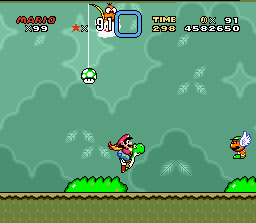
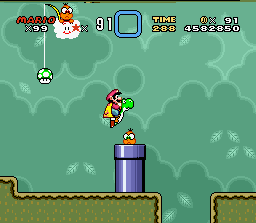
This Lakitu is an evolution of the extending pipes found in Donut Plains 4; the Lakitu�s head acts as an extension but also has the other dangers listed above. It also immediately expands (pictured below, left), increasing the height of the pipe to the point that Mario needs real momentum to get above the Lakitu�s head, which can be as high as seven blocks in its full extended position. The problem is that this momentum jump will probably collide with the 1-up, beginning the Spiny rain.
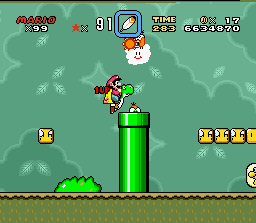
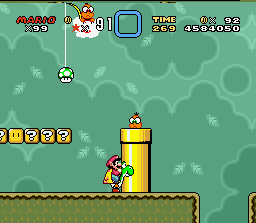
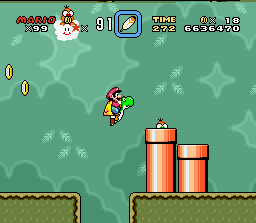
After the expansion comes an evolution/expansion (pictured above, middle), which is just slightly taller than the standard challenge, but adds the coin-block ceiling to the left. The ceiling stops lower, long-range jumps and can also trap slower players in a confined space with an increasing number of Spinies. It doesn�t do either of those things particularly well, but it�s possible. The last real iteration of this (above, right) evolves the challenge by putting the pitfall in front of the Lakitu, causing the player to jump both in one go.
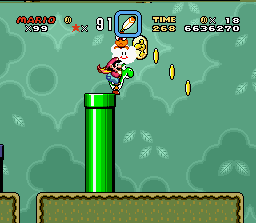
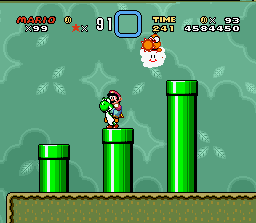
The connection between the Lakitu pipe and the extending pipe is clear in this level, because after the Lakitus challenges, an extending pipe stands in as a mutation. The extending pipe does the same job it did in Donut Plains, forcing the player to hurry, but this time the eight-block height brings Mario right up to the hovering Lakitu, making the challenge quite a bit more dangerous. Skipping ahead, this challenge itself evolves into the right image above. Here the challenge of the extending pipe is magnified. The player still needs to keep Mario�s momentum up, because the Lakitu can and will land Spinies on the pipes, giving Mario no room and no time to deal with them. They�ll also fall with Mario into the gaps between the pipes, and waiting at the end is the Lakitu, hovering hazardously in the air.
The cadence ends with a pinnacle challenge that nearly fills the screen with enemies. The variety of enemies is actually quite surprising; only the Lakitu was present in the level before this point. What all of these enemies have in common, though, is that they�re not susceptible to an easy jump.
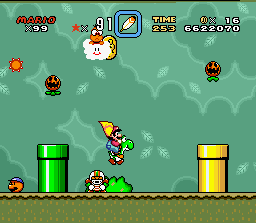
The Chuck, Pumpkins and dropped Spiny enemies are all set up in such a way that a combat jump isn�t going to solve problems. Instead, it�s better to simply get in and out of this pipe-contained valley as soon as possible. There�s just too much going on. Thus, although the enemies are a major evolutionary shift away from what has come before in this level, they�re nevertheless appropriate for the cadence and theme that govern the structure.
CHOCOLATE ISLAND 2
Chocolate Island 2 is built around a variable midsection, a section which is the only real point of interest from a design perspective. The essential idea behind the level is that the second section will change based on whether Mario has collected a certain number of coins or has a certain amount of time on the clock. The specific number of coins or seconds doesn�t matter for our study; there�s no lasting lesson to be learned from the specific number. The overall premise�that the content of the level changes based on how the player plays it�is interesting as a concept too, but that�s not a lesson in itself. It would be easy for a young designer, attempting a similar level, to make a level with dynamic sections that feels completely incoherent. Chocolate Island 2 coheres because it stays within the preservation of momentum theme no matter which middle section the player encounters. (It does not, however, feature the typical evolution/expansion progression because these sections are not in sequence.)
The section commonly referred to as "A" is the only section in the game that requires a soaring cape jump to reach the end of a level. While there have been many sections that suggest or even reward flight with the cape, none have forced the issue. Moreover, not since Donut Plains 1 has any section of a level rewarded the player with a secret path for sustaining Mario's horizontal momentum through the air. Section A of Chocolate Island 2 does both of these things, and in the greater context of the game this makes sense. The ability to sustain Mario's flight with the cape indefinitely (via an "air bounce") was included in the game probably as a difficult skill that few people would master. And perhaps for a short amount of time around Christmas, 1990, that was true. Since then, players all over the world have used sustained flight to break the heck out of the game. This is the one case in which sustained flight with the cape is actually necessary.
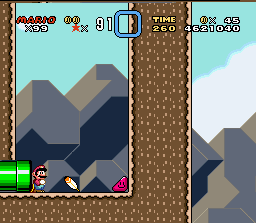
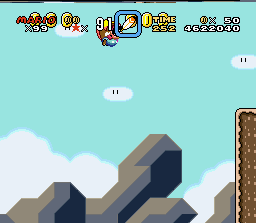
Naturally, this involves preservation of momentum in two different ways. Obviously, the running start is a preservation of momentum skill event, but actually sustaining and controlling the flight is a preservation of momentum challenge as well. To emphasize the player�s need for disciplined control over Mario�s flying momentum, the coins are set into single lines that are only accessible to the tightest air-bounces. It�s oddly reminiscent of the sky full of coins in the pipe-section in Donut Plains 1, though it�s odd because it comes so late in the game. Then again, we can�t judge the designers for trying not to overexpose the technique which they must have known could break their game.
The middle section known traditionally as the �B� is still a series of preservation of momentum-themed challenges, but it�s impressive how different it is from the previous option. This section features sloping cliffs interrupted by variously pathed Wing Koopas. The effect of the cliffs is rather like that of the icy levels elsewhere in this theme; because Mario can�t really come to a safe, easy stop and so his momentum is never going to come to rest, no matter what the player wants. This effect is the basis for a tricky design idea. The direction of the slopes changes after three slopes.
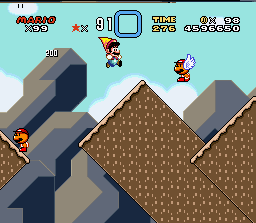
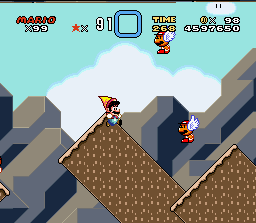
Once the slopes start facing away from Mario, it�s easy for the player to simply start enemy-bouncing and cape-gliding to avoid slipping into the bottomless pits below. The problem with this is that the Wing Koopas set the player up for a nasty surprise. There are two chains of Koopas, if we count the big d-distance gap in the middle to be the start of a new challenge. In each chain of Koopas, they all start their patrols within the same two blocks of height, and so bouncing from one to another is easy. The fifth Koopa in both sets, however, starts its flight about three blocks higher and is cued to begin the upward portion of his flight just a little bit earlier. This means that players who have gotten in a groove bouncing from one Koopa to the next will be rudely interrupted by a Koopa who is suddenly too high. This effect is enhanced because the changes in Koopas and sloping ramps are on different cycles, every three vs. every five. This is a subtle incorporation of the intercepts side of the composite, which emphasizes fast reactions and adaptations rather than steady forward momentum.
The middle section usually referred to as �C� offers yet another very different iteration of a preservation of momentum series of challenges. This section brings back the Rex enemy not seen since the beginning of the game�but unlike section A, this decision to bring back an early element makes a lot of sense. These stacked cliffs are filled with syncopated Rexes that offer a clear but difficult jump-path for Mario.
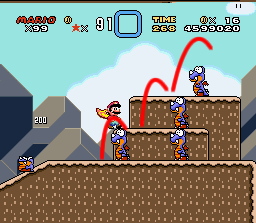
The reason these are Rexes and not Koopas is not just because Rexes are taller and make for more difficult jumps, but also because Rexes always walk off cliff edges (whereas Koopas can either walk off or turn around), making it obviously imperative that the player hit Mario�s jump points before a Rex is blocking the way. There are a couple of fairly obvious but less likely alternatives: because of the Rex�s tendency to walk off cliffs, Mario could simply wait. As it has been explained elsewhere, however, waiting is boring and players aren�t likely to do it. The other option is combat, and that would be a reasonably easy option, but even then the player still needs to hustle Mario up the slope to stay out of a situation in which the Rex is dropping down on Mario, which makes combat almost impossible. Mario has to be at an even or superior height to his opponent for combat to work in this game.
While the rest of the level offers other preservation of momentum and intercept challenges, none of them teach us anything we couldn�t learn better from another level.
STAR WORLD 5
Since all Star Road levels tend toward some kind of design extreme, Star World 5 shows us a lot of game design ideas that become obvious to an observer because of their extremity. To start, we see in this level one of the design features that has been mostly (and perhaps oddly) absent from Super Mario World: the falling platform. Comparatively speaking, there were a lot more of these in SMB3, and the paucity of them in Super Mario World suggests that the designers were interested in moving on. Nevertheless, this level is filled with them, and long chains of them form two major sections.
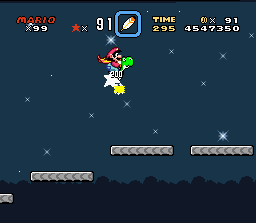
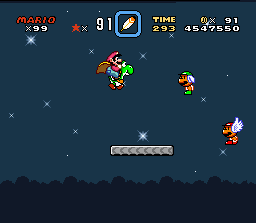
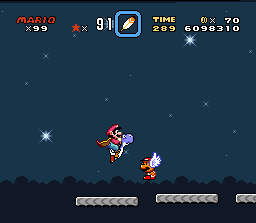
What is also clear in these sections is the placement and behavior of momentum-assisting enemies. Notice how the Wing Koopas aren't in a position that makes jumping terribly difficult. Instead, they're configured so that it's easy for the player to bounce off them and glide over the falling platforms, bypassing them, even when those platforms change elevation.
There is also this rather extreme exercise pictured below, which involves the string of coins mechanic, and a P-switch that activates it. The reason I call this extreme is that it goes so far into the preservation of momentum theme that it becomes an abstraction of the idea. The player has to learn (unfortunately through trial and error) to plan a route for Mario that will allow him to preserve his momentum while avoiding obstacles and getting to the right place�which should eventually be the location of the secret exit.

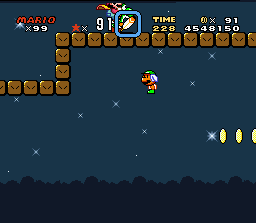
One could fault the designers for forcing the player to do this exercise without giving them clear indication of what's happening off-screen. Such a criticism would probably be warranted, although within the experimental and extreme context of the Star Road/Special zones it's somewhat more acceptable than if it were in a level on the straighter path to the end of the game.
CHOCOLATE SECRET
Although Awesome is definitely the pinnacle of this theme for more than one reason, Chocolate Secret emphasizes one aspect of the theme more fully than any other level: preservation of momentum by avoidance. The preservation of momentum theme rests in the platforming declension, and we�ve classified it that way because in these levels, action solutions to problems are less appropriate than platforming solution (though obviously the game is easy enough that experienced players can often substitute one for the other). It would be a mistake to equate the presence of numerous enemies with a level being in the action declension, and this level shows us why. Levels rich in enemies are often action levels, but it�s the way that the player deals with the enemies that really matters, not there mere quantity. This level puts Mario into challenges where speed is of the utmost essence; in large numbers, the football is rather deadly. (How many times can you write that sentence and really mean it?)
Most of the challenges in this level that require haste do so because of a gradient in the terrain. Most of the enemies in this level are either resistant to fireballs or completely immune to them. This is an obvious limit on action solutions to the problems presented, but in addition to that, the slopes present in this level make it much harder to use the cape or Yoshi�s tongue to kill enemies. The image below isn�t the standard challenge�we might in fact call it a training-wheels challenge because there�s a reduction in penalty (no pitfall) and a simplification, since the Buzzy Beetle doesn�t fire projectiles like the upcoming Chucks will.
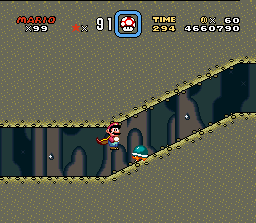
Because the Beetle is coming downwards at Mario, his attacks are more difficult to target, and this is doubly true with the very low ceiling. What the player really needs to do is quickly run up the hill into the part of the tunnel that has some headroom. This allows Mario to either jump over the enemy, jump on it. In either case, losing Mario�s full momentum will result in having to face the Beetle on the hill, making it harder to avoid damage.
The next challenge is the standard from which the rest of the cadence is derived. The Kicking Chuck launches one of the game�s only truly unpredictable projectiles. The football in question bounces at variable heights between two and six blocks, and when two of them are on screen at the same time it can get quite crowded. Because the Kicking Chucks never stop launching projectiles, and because they will turn to face Mario, the easiest solution is just to run and jump fast enough that they never get a chance.
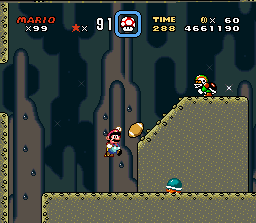
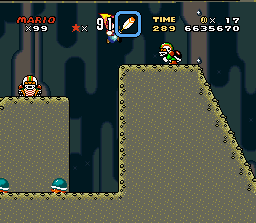
Unlike the Pitching Chuck, which starts firing as soon as Mario sees them, the Kicking Chuck has a built-in delay. That delay helps, but there�s still the problem of climbing these slopes. It�s easy enough to defeat the lower Chuck with a cape attack before the barrage of footballs begins, but that removes the easiest path. The simplest thing to do is charge the first Chuck, bounce off his head to get momentum and height to get over anything that might be behind him (like another Chuck). In either case, the player isn�t really engaging these Chucks, just rushing past them.
Following the standard, there is an evolution/expansion that increases the gradient of the hill and the distance Mario has to cover to get past the Chuck. It also features a pipe that backs the Chuck and narrows the aperture through which Mario can slip while maintaining momentum, which constitutes the evolution, minor though it is. The expansion here is in the distance Mario has to cover. From the bottom lip of the previous slope to the pinnacle of the current slope, Mario has to ascend eight blocks and travel twelve laterally�4 of which are pitfall d-distance.
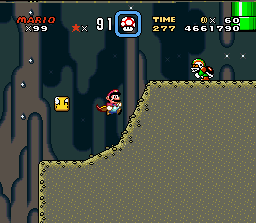
All the while, the Chuck can start kicking footballs if Mario isn�t up the slope fast enough. For this reason there�s only one Chuck; two seems like it might have been too cruel.
The effect of two Chucks kicking in a confined space makes up the last challenge, an evolution that boxes the footballs in. I consider this an evolution because the terrain is actually much more navigable without the steep and momentum-defeating slopes, and so all the jumps and runs are much shorter and easier. By that same token, the terrain can be a real hazard if the player doesn�t exit quickly through the pipe. The footballs can really accumulate.
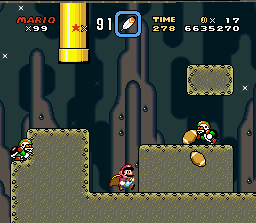
This is only hard if Mario stops, and so is about as obvious a lesson in the value of preserving momentum as there is going to be in the game.
Next there is a section whose intent is clear, but whose failure is the more obvious for that clarity. This set of giant, plunging slopes would make for a great reward-by-fun section if it were executed a little bit more carefully. Rewards-by-fun require a baseline level of ease punctuated by slight challenges and a rapid stream of rewards.
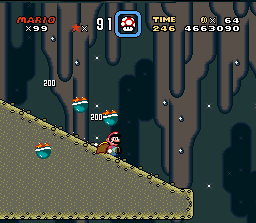

The basic idea here is that Mario can slide all the way to the bottom, knocking off Buzzy Beetles as he goes. The baseline level of ease required by a reward-by-fun section is appropriate, but the small-but-present stakes aren�t really there. There is one small enemy-pit, but it�s trivial and requires no reaction. The presence of the Buzzy Beetles also does nothing for the player�s interest; consecutive slide kills don�t add up to extra lives and there�s no complication to make this part fun. It�s interesting though that a very similar idea shows up years later in Yoshi�s Island (level 5-3) as a skiing section, which is one of the most well-executed rewards-by-fun ever devised in games.
The last section gives us two instances of the same idea: an evolution challenge featuring uneven terrain and lots of enemies who aren�t easy to fight and require either swift action or all-out avoidance. The first part of this section shows us crenelated terrain swarming with the Spiny enemy. Because they�re small and invulnerable to jump and fireball attacks, these enemies are a pain to deal with, especially in large numbers.
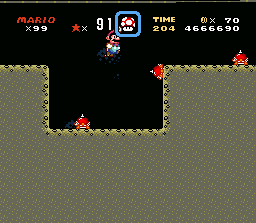
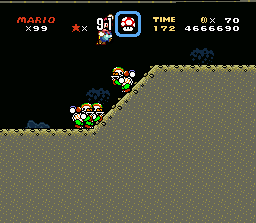
Stopping to enter combat is a bad idea because there are enemies coming in both directions; it�s better to just bounce off or hit the right spots and keep going. Later we see a very similar idea, but evolved with the Chuck in place of the enemy. The terrain is simply sloping instead of jagged, but it�s very much a mutation of the first example. Because of the slopes, it�s not particularly easy to defeat the Chucks with a cape attack; Mario has to be even with his target. Jumping on them is only going to slow Mario down without doing real damage, and because of the large number of Chucks in the area (6 in all), it can get too crowded very quickly, so it�s better to just avoid the enemies by large jumps, glides and opportune enemy-bounces.
Sandwiched in between these two is the kind of dropping-platform challenge that occurs in Vanilla Dome 2 but which is actually given real development here. This instance lacks a star like its predecessor had, but it does actually show us a nifty evolution consistent with the rest of the level. You can see here how the first section�s flat platforms become variously graded the second time around.
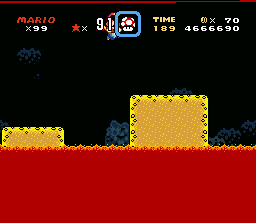
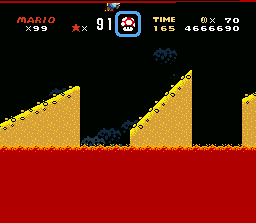
The rush across these sinking platforms also serves the added purpose of warming the player up for the upcoming Chucks, which need to be traversed a little quicker than the Spiny enemies before.
VALLEY OF BOWSER 4
Valley of Bowser 4 introduces the Digging Chuck whose abilities are particularly useful for how they work in a variety of situations. The variety possible with this boulder is what makes this level a more developed version of Chocolate Secret. The boulder that this Chuck launches has much greater utility than most intercepts, because it depends on the terrain more meaningfully than any of the other launched intercepts in the game. For example, in the standard challenge, there are three different bounces.
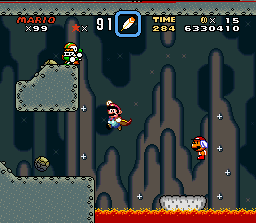
The boulder�s bounces depend on the angle of the terrain below, and so each terrain configuration that follows the standard challenge will have nuances which the player probably won�t appreciate the first few times through. Because the intercept moves slowly, however, there�s still time for the player to react. This level is still firmly in the preservation of momentum theme, however. Just like in Chocolate Secret, the best strategy is to keep Mario�s momentum up to get by the challenges before another boulder comes down. The sinking platform which comes after the Digging Chuck reinforces this, forcing Mario to have to jump very quickly to avoid a lava death.
This level is all about evolutions and mutations, and they start coming quickly. The second challenge evolves the terrain so that Mario has to jump over the oncoming boulder while fighting the slowing angle of a ramp. The bounces are more troublesome here, as they give the boulder extra height while Mario charges up from underneath.
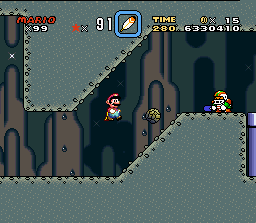
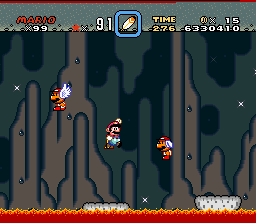
Although it evolves the terrain configuration to a more challenging shape, the second challenge abandons the sinking platform element found in the standard challenge. The third challenge, pictured above on the right, brings this element back, but both evolved and expanded. This is an unusual configuration. Although there are levels which juggle two cadences, and plenty of mutations which change the emphasis of a previous challenge, this challenge is neither of those things. This challenge is definitely an evolution of the standard challenge, because it does increase the complexity of that first challenge, as is plainly obvious. It�s just that it�s only an evolution of half of the standard challenge, since it drops the Chuck. This would fit better with what we know of the game if this challenge, say, took away intercepts and focused only on momentum�but it doesn�t! There�s no change in declension at all; it�s still in the preservation of momentum theme.
The fourth challenge is also tricky to explain.
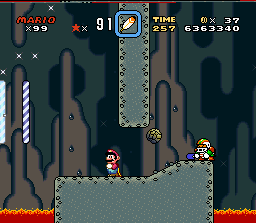
I call this a mutation because it decreases the qualitative complexity of the challenge greatly. What could be simpler in this cadence than a Digging Chuck with hardly any sloping terrain? At the same time, the critical area to pass through (the aperture in the middle) is contracted, suggesting that the critical area here is a contraction. So what the player has to do is obvious, about as simple as the standard challenge overall, but qualitatively different. A challenge whose most noteworthy feature is a qualitative change that is neither more nor less complex is a mutation, and that is what this appears to be. This ruling is not ironclad, however, and would endure other interpretations meaningfully.
Challenge five, on the other hand, is quite easy to explain, as it�s just the standard challenge with an extra layer of terrain to complicate the bouncing.
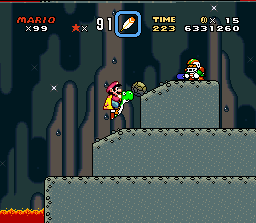
It�s quite a bit easier than other challenges in this level because Mario can just run under the Chuck without having to do any jumping (although the player may jump excitedly because they expect to do so), but it still obviously fulfills the preservation of momentum theme.
The sixth and seventh challenges are structurally quite simple. The sixth challenge inverts challenge two, to a degree. Instead of racing up a slope to beat the Chuck�s launched dirt, Mario has to race downwards and then leap off the platform before it lands.
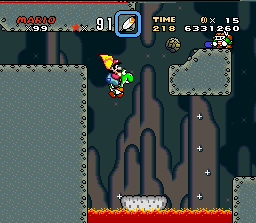
Even if the player is keen to use Yoshi�s tongue or the cape to defeat the dirt balls, midair attacks are by far the hardest to execute, so it�s much easier to just drop and jump quickly to the safe platform on the right. Challenge seven reverses the order of the standard challenge, by leading with a single sinking platform, and then having the player charge up and past (or through) the Chuck waiting at the top.
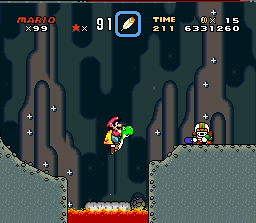
Again, this is a relatively simple challenge that even reduces some of the delta height of earlier jumps. It totally removes the Wing Koopa and doesn�t replace it with anything else, either. It�s important that not every challenge gets harder; a good cadence requires both upward and downward motion along the axis of obstacles.
Now, although the change of pace in challenge seven is a welcome one in a level with a lot of lava pits, this challenge also presents a problem. The seventh challenge would have been better placed at the beginning of the level, because it reveals how the preservation of momentum is the key to this level. The downwards slope pictured to the left is one of the easiest ways in the game for Mario to quickly accumulate momentum, and a simple jump at the bottom will easily propel him over the Chuck beyond, without ever having to use that platform (even though both are fairly easy to do). This is not to say that a challenge like this is inappropriate in its place in the level. So although the ease of this challenge is appropriate and it even does a good job injecting some variety into the cadence, the challenge would have been better used at the beginning because of how clearly it reveals the level�s theme to the player.
The last challenge combines every element in the level into one climactic stretch, with something new thrown in as well.
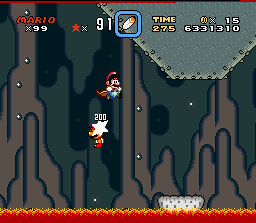
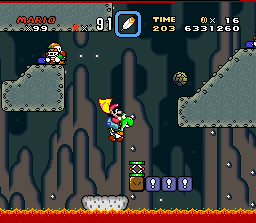
The long lava pit of challenge three appears first, complete with a necessary enemy-bounce. This leads into the expansion portion of the challenge, where the player has to quickly (because of the sinking platforms and oncoming boulders) get through two consecutive overhead Digging Chucks. To add to this, hitting that springboard quickly enough to avoid the boulder requires very prompt action, since the Chuck starts throwing boulders well in advance of Mario being on the platform, and the springboard has a built-in delay. Some credit has to go to the design team though, in that they gave the player a second route through the hardest challenge. Timed correctly, the player can go right past the springboard and cape-glide to the distant platforms under the second chuck, to the right. It isn�t easy, but real, viable options make the hardest challenges less frustrating (a fact which the designers used everywhere except Tubular).
AWESOME
The climax of the preservation of momentum theme is similar to the pinnacle challenges of the other themes in terms of what it demands from the player, but quite different in terms of construction. The process of iteration has made it so that most of the game�s escalating difficulty was the result of increasingly convoluted game ideas, repeated. Accumulation, when used, is used sparingly�but not in this level. In Awesome, every imaginable idea from the theme is piled up into one level (and in some cases, one challenge). There are small instances of intricate pile-ups, as in Tubular, Forest of Illusion 4 and Vanilla Fortress, but those are essentially complicated A plus complicated B, whereas in this level it's as many as six design ideas piled up�although not immediately. Rather, what we see throughout the level is several ideas coming together and forming a single unit, followed by another group of ideas coming together to form a single unit. These two meta-idea units then stack.
The overarching idea which reveals this level's theme is the slippery frozen terrain which preserves Mario's momentum after movement whether the player likes it or not. This is, of course, not the first time we've seen this. Back in Donut Secret 2 this idea was matched up with some slow-moving intercepts and small but dangerous pit jumps. Here the frozen/slippery ground is a little more varied, although it still generally adheres to that idea. It starts with a series of valleys; because of the global effect of frozen/slippery ground, even these otherwise simple enemy-filled pits are much more dangerous than they would normally be. What makes these pits difficult, and what makes the second half of the level difficult as well, is the way the intercepts come towards Mario. If you've read the intercepts theme, you'll know that intercepts so far have mostly fallen into three groups, and that these intercepts don't really fit into any of them. These Koopa shells have a flight arc that vaguely resembles the Super Koopas in Donut Plains 1 and Butter Bridge 2 (the second of which also features kicked shells), but the resemblance isn�t close enough that the skills from one translate to the skills of another, especially with the ice in mind. Moreover, the Super Koopas are a medium speed enemy; the Koopa shells travel at max speed. So while the player isn�t completely unprepared for these situations, it�s a lot more challenging that it appears from the picture.
The evolutionary progression of these pits comes in two straightforward sets. The first set consists of these three valleys, which represent a mutation followed by an evolution. You can see here how the pipe bisecting the first valley is removed, making a cape-glide possible�but the number of enemies goes up, offsetting some of the ease. (Note that this is a tricky case: this change seems to be an attempt at a difficulty-neutral scenario, which would be a mutation because so much stays the same. But this is a judgment call.)
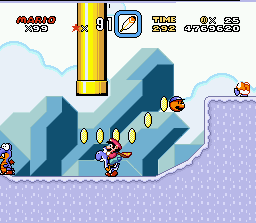
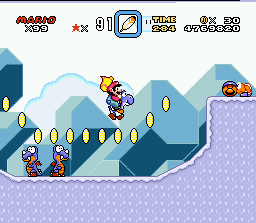
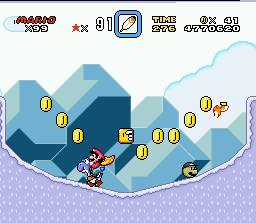
The first two valleys are the same shape; the third is deeper. This deeper valley actually retains an element of the first valley, in the coin-block which sits above its lowest point, possibly confining Mario�s jumps. The most obvious aspect of the evolution here is the rainbow shell which makes this valley even more dangerous than its predecessors. But I also count the deepness of the valley and coin-block as an evolution, because it�s much easier for the player to be trapped when having to go so far uphill, with the jump possibly obscured by that coin-block, narrow though it is.
In the second set of challenges, we see the valleys evolve into watery pits. The first pit is not terribly dangerous, because so much of the water that Mario could land in is safe from the trajectory of the shell.
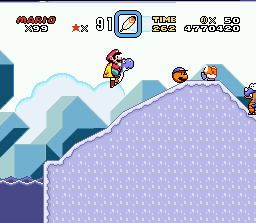
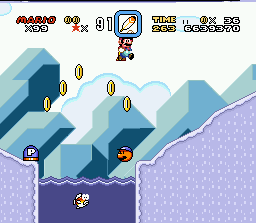
The second watery pit is a combined evolution/expansion. To start, the d-distance in the jump expands. Secondly, there are two intercepts where there used to be one, although the second intercept is now a patrolling fish in the water, adding a qualitative difference. But the real hook of this challenge is the p-switch which is a total red herring. Because of the global ice effect, it�s much easier for the player to simply bypass this switch and glide across the watery pit rather than trying to hit it, not fall, and then jump onto the transformed coins.
After a total action crossover on some flat ice that punctuates the level nicely, the real challenges of Awesome begin. Throughout this section, the player will be endlessly beset by waves of leaping fish who are immune to standard jumps and whose angle makes for a difficult kill. Combined with the ice, it seems as if Mario has no choice but to always be hurrying forward. There�s even a star in the first coin-block, if the player somehow knew to bring a Koopa shell to retrieve it (or could nail the Yoshi-dismount jump without taking damage).
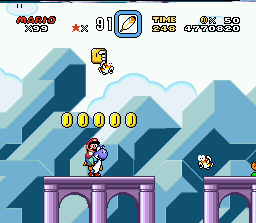

With or without the star, this is an unforgiving section. The environmental demand to constantly move forward is countered by a series of escalating obstacles. The first obstacle, the b-standard of the level, is a simple jump to a second platform occupied by a Rex and a fire-flower. The Rex is typical platform fodder, but the fire-flower is just cruel. Even with a star, this section is going to be much more difficult if the player can�t cape glide, and that exposed fire-flower will take away Mario�s ability to do that. The designers turn a powerup into an obstacle! The leap from that platform is even worse as the platform is going to be obscured by the body of the Banzai Bill for crucial seconds that allow the leaping fish to clutter the skies.
The Banzai Bill problem sees an expansion-by-contraction, as the relevant platform shrinks to one. Fortunately for the players, the Banzai Bill is lower this time and can probably be used in an enemy-bounce. That bounce is not without its problems, though, as those leaping fish are still going to be soaring around while Mario descends slowly onto the next platform.
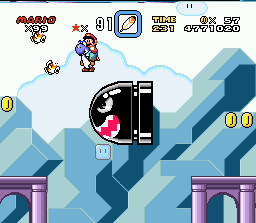

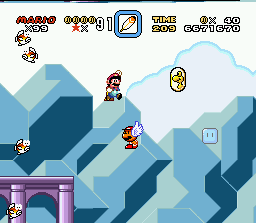
This challenge then evolves A-to-A, but removes the Banzai Bill; there are still plenty of intercepts, though. The leap from a one-block platform to another one-block platform amidst an endless flood of enemies would be hard enough, but these platforms are icy. The final challenge is actually somewhat easier, as the Wing Koopa serves as the safest platform in the whole level, making for an easy bounce-target that can get the player to the final ledge. Technically this last challenge is an evolution/expansion that substitutes an enemy for a platform and increases the overall d-distance, but the level was so hard before that it seems like it could only get easier. And so it does.
Where the pinnacle of the periodic enemies theme was great because it perfectly executed a standard cadence, this level is fascinating because it totally inverts the lessons of the theme. The preservation of momentum theme is all about the virtue of moving quickly to save Mario trouble he doesn�t need to deal with. This level forces that kind of momentum out of him, and yet penalizes the result with intercepts, narrow platforms and icy physics. This level is like taking a final examination in avian anatomy by having to wrestle an ostrich�the curricular knowledge was useful, but who was expecting to apply it like this? Because of the star and because Mario can still plausibly take damage without dying, this level is still fairer than Tubular, but it only gets away with being as bizarre as it is because it�s in the Special world.